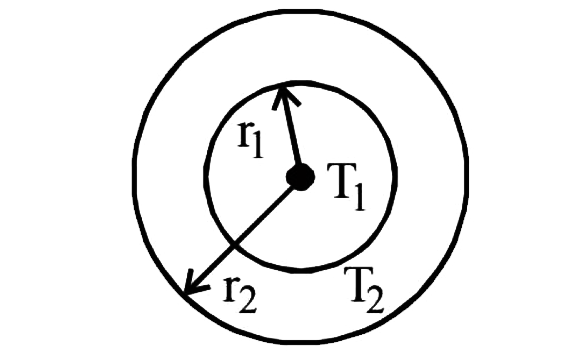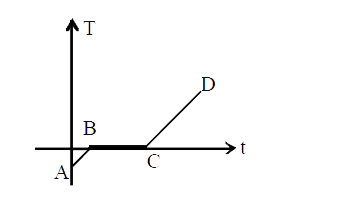A cylindrical rod of heat capacity in a room temperature is heated internally by heater of power ,
The steady state temperature attained by the rod is . Fin the following:
(a) The initial rate of increse in temperature
(b) The steady state rate of emission of radiant heat.
If the heater is switched off, find
(c) The initial rate of decrease is temperature
(d) The rate of decrease in temperature of the cylinder when its temperature falls to and
(e) The maximum amount of heat lost by the cylinder
The correct Answer is:250 W
Step by step video, text & image solution for A cylindrical rod of heat capacity 120 J//K in a room temperature 27^(@)C is heated internally by heater of power 250W, The steady state temperature attained by the rod is 37^(@)C. Fin the following: (a) The initial rate of increse in temperature (b) The steady state rate of emission of radiant heat. If the heater is switched off, find (c) The initial rate of decrease is temperature (d) The rate of decrease in temperature of the cylinder when its temperature falls to 31^(@)C and (e) The maximum amount of heat lost by the cylinder by Physics experts to help you in doubts & scoring excellent marks in Class 12 exams.
Topper's Solved these Questions
- BOOK - MOTIONCHAPTER - HEAT - 1EXERCISE - EXERCISE -3 (Level - II) Subjective | JEE Advanced11videos
HEAT - 1
- BOOK - MOTIONCHAPTER - HEAT - 1EXERCISE - EXERCISE -4 (Level - I) Previous Year | JEE Main10videos
HEAT - 1
- BOOK - MOTIONCHAPTER - HEAT - 1EXERCISE - EXERCISE -2 (Level - II) Multiple Correct | JEE Advanced16videos
HEAT - 1
- BOOK - MOTIONCHAPTER - GRAVITATIONEXERCISE - Exercise - 4 Section - B Previous Years Problems15videos
GRAVITATION
- BOOK - MOTIONCHAPTER - HEAT TRANSFER & THERMAL EXPANSION EXERCISE - Exercise - 3 Section-B19videos
HEAT TRANSFER & THERMAL EXPANSION
Similar Questions
A copper calorimeter of mass 100 gm contains 200 gm of a mixture of ice and water. Steam at 100°C under normal pressure is passed into the calorimeter and the temperature of the mixture is allowed to rise to 50°C. If the mass of the calorimeter and its contents is now 330 gm, what was the ratio of ice and water in beginning? Neglect heat losses.
Given : Specific heat capacity of copper
=0.42×103Jkg−1K−1.
Specific heat capacity of water
=4.2×103Jkg−1K−1
Specific heat of fusion of ice
=3.36×105Jkg−1
Latent heat of condensation of steam
=22.5×105Jkg−101:35View SolutionThe figure shows a system of two concentric spheres of radii r1andr2 are kept at temperature T1andT2, respectively. The radial rate of flow of heat in a substance between the two concentric spheres is proportional to
 03:45View Solution
03:45View SolutionHeat is supplied to a ice at a constant rate Temperature variation with time is as shown in figure. Then –
 07:56View Solution
07:56View SolutionSuppose the gravitational force varies inversely as the nth power of distance. Then the time period of a planet in circular orbit of radius 'R' around the sun will be proportional to
01:26View SolutionWhich of the following is more close to a black body ?
02:24View SolutionAssertion : Heat is supplied at constant rate from one end of a conducting rod. In steady state, temperature of all points of the rod becomes uniform.
Reason : In steady state, temperature of rod does not increase.01:36View SolutionThe temperature of a room heated by heater is 20∘C when outside temperature is −20∘C and it is 10∘C when the outside temperature is −40∘C. The temperature of the heater is
04:35View SolutionA cylindrical rod of heat capacity 120J/K in a room temperature 27∘C is heated internally by heater of power 250W, The steady state temperature attained by the rod is 37∘C. Fin the following:
(a) The initial rate of increse in temperature
(b) The steady state rate of emission of radiant heat.
If the heater is switched off, find
(c) The initial rate of decrease is temperature
(d) The rate of decrease in temperature of the cylinder when its temperature falls to 31∘C and
(e) The maximum amount of heat lost by the cylinder04:33View SolutionThe two ends of a metal rod are maintained at temperatures 100∘C and 110∘C . The rate of heat flow in the rod is found to be 4.0j/s. If the ends are maintaind at temperatures 200∘C and 210∘C, the rate of heat flow will be :
04:28View SolutionAn object is being heated by a heater supplying 60W of heat. Temperature of surrounding is 20^(@)C and the temperature of object becomes constant at 50^(@)C Now the heater is switched off What is the rate at which the object will lose heat when its temperature has dropped to 30^(@)C .
02:19View SolutionA metal ball of mass 2kg is heated means of a 40W heater in a room at 25^(@)C . The temperature of the ball beomes steady at 60^(@)C . Find the rate of loss of heat to the surrounding when the ball is at 60^(@)C .
03:04View SolutionA block is kept in a room which is at 20^(@)C . To raise the temperature of the block, heat is given to it at a constant rate of 600 watt (using an electric heater). The temperature of the block rises with time as shown in the graph. The slope of the graph at time t = 0 is 3^(@)C s^(-1) . Once the temperature rises to 60^(@)C , the heater is switched off and another heater is switched on to maintain the temperature of the block at 60^(@)C . This new heater supplies heat at a constant rate of 100 watt. Assume that heat capacity of the block remains constant for the range of temperature involved. (a) Explain why the slope of the given graph is decreasing with time. (b) Calculate the heat capacity of the block. (c) If the 100 W heater is also switched off, what will be initial rate of cooling of the block? (d) Assuming that rate of heat loss by the block to the surrounding is proportional to difference in its temperature with surrounding, calculate the heat radiated per second by the block when it was at 30^(@)C .
02:19View SolutionA metal block is placed in a room which is at 10∘C. It is heated by an electric heater of power 500W till its temperature becomes 50∘C. Its initial rate of rise of temperature is 2.5∘C/sec. The heater is switched off and now a heater of 100W is required to maintain the temperature of the block at 50∘C. (Assume Newtons Law of cooling to be valid)
(i) What is the heat capacity of the block ?
(ii) What is the rate of cooling of block at 50∘C if the 100W heater is also switched off ?
(iii) What is the heat radiated per second when the block was 30∘C ?09:37View SolutionA metal block is placed in a room which is at 10^(@)C for long time. Now it is heated by an electric heater of power 500 W till its temperature becomes 50^(@)C . Its initial rate of rise of temperature is 2.5^(@)C//sec . The heater is switched off and now a heater of 100W is required to maintain the temperature of the block at 50^(@)C . (Assume Newtons Law of cooling to be valid) What is the rate of cooling of block at 50^(@)C if the 100W heater is also switched off?
03:45View SolutionAssertion : Heat is supplied at constant rate from one end of a conducting rod. In steady state, temperature of all points of the rod becomes uniform.
Reason : In steady state, temperature of rod does not increase.03:50View SolutionA metal block is placed in a room which is at 10^(@)C for long time. Now it is heated by an electric heater of power 500 W till its temperature becomes 50^(@)C . Its initial rate of rise of temperature is 2.5^(@)C//sec . The heater is switched off and now a heater of 100W is required to maintain the temperature of the block at 50^(@)C . (Assume Newtons Law of cooling to be valid) What is the rate of cooling of block at 50^(@)C if the 100W heater is also switched off?
View Solution

